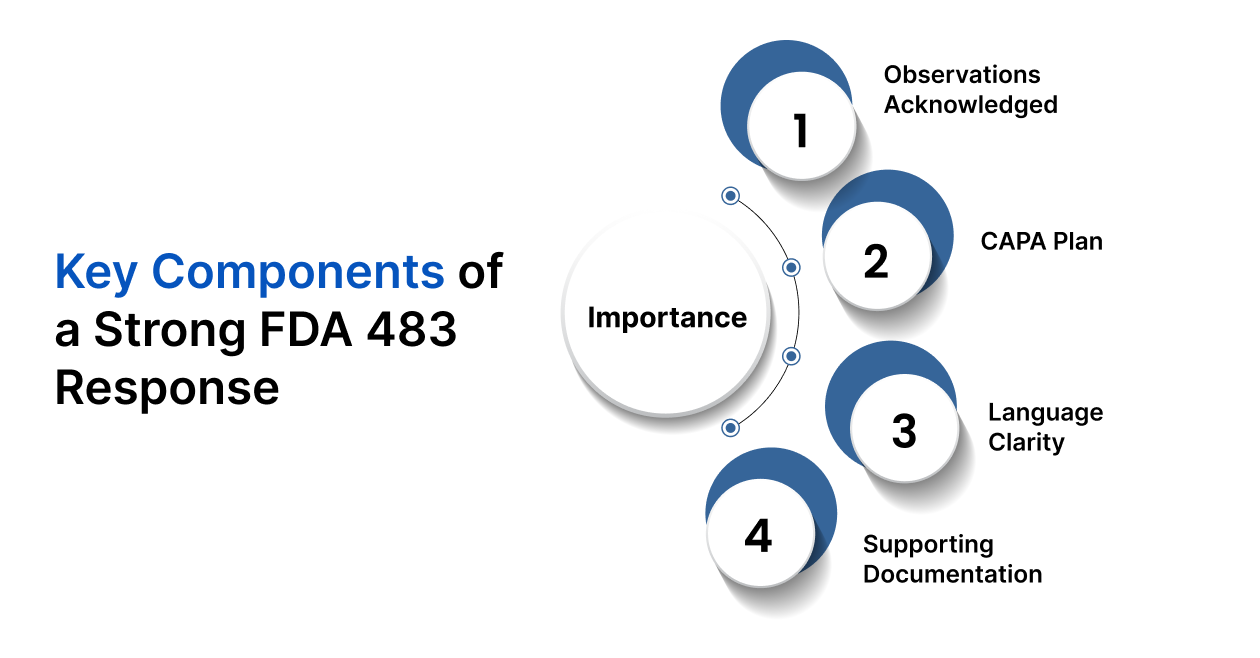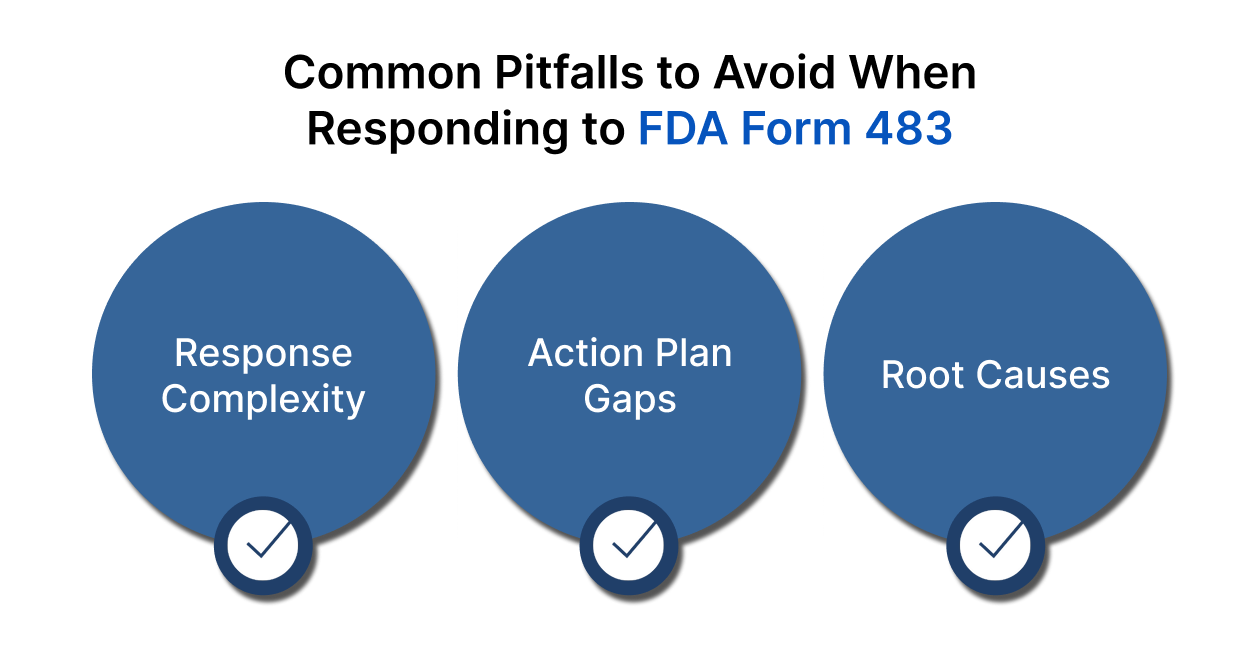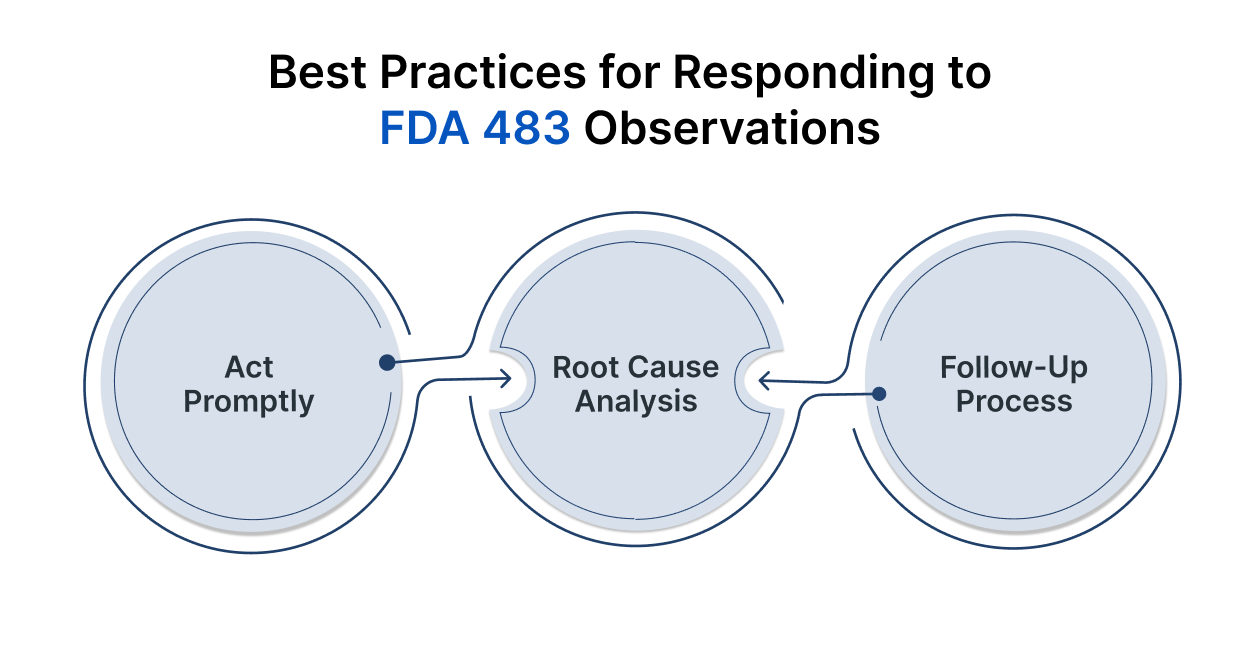Getting hit with an FDA Form 483 should be a wake-up call. As these observations are often made public, your company is under a tangible risk of losing reputation and consumer trust. An effective response is critical at this stage, as failure can lead to product approval suspensions and delays that impact revenue as well as market share.
However, with the right response strategy, businesses can turn this challenge into an opportunity to demonstrate their commitment to compliance, resolve issues quickly, and avoid future complications. This blog will outline effective strategies for responding to FDA Form 483 and ensuring your company is well-prepared for future inspections.
What is FDA Form 483?
The FDA Form 483 is a document issued to a company when FDA inspectors find conditions that may violate FDA regulations during an inspection. It typically includes observations about
- Improper manufacturing processes
- Failure to follow Good Manufacturing Practices (GMP)
- Problems with quality control systems
However, it is important to understand that receiving a Form 483 does not automatically mean the company will face penalties or further legal action. It simply signals the need for corrective action.
Key Components of a Strong FDA 483 Response

A strong response to an FDA Form 483 is essential for addressing the concerns raised during an FDA inspection and avoiding further regulatory actions. Responding effectively not only resolves the immediate issues but also demonstrates your organization’s commitment to maintaining high compliance standards.
Here are the key components of an effective FDA Form 483 response:
1. Acknowledging the Observations
The first step in crafting your response is to acknowledge the observations made by the FDA inspector. Acknowledging the issues, even if you disagree with some observations, is vital for showing the FDA that you take the matter seriously and are committed to resolving it.
- Avoid Defensiveness: Instead of arguing or making excuses, focus on a clear, objective analysis of the observations.
- Demonstrate Ownership: Show that your company takes full responsibility for addressing the issues raised.
2. Developing a Comprehensive CAPA Plan
A Corrective and Preventive Action (CAPA) plan is one of the most critical components of your response. This plan must outline how your organization will address the observed deficiencies and prevent them from recurring in the future. A strong CAPA plan involves:
- Corrective Actions: Define what steps will be taken to fix the current issues and ensure compliance with FDA regulations moving forward.
- Preventive Actions: Outline how you will prevent similar issues from arising in the future. This could involve process improvements, new procedures, or more rigorous training.
3. Clear and Concise Language
In your response, avoid using complex jargon or legal language. The goal is to clearly communicate your plan for compliance without causing confusion. The FDA wants to see that you have a practical and effective plan to resolve the issues, not an overly technical explanation that doesn’t offer clear solutions.
- Be Transparent: Clearly explain what went wrong and how you plan to fix it.
- Avoid Over-Complicating: Simplicity is key. Overly complicated or technical responses may obscure the issues at hand.
4. Supporting Documentation
The FDA expects you to provide evidence to support your corrective actions. This could include:
- Training Records: Show that you have educated your team on the updated processes and compliance requirements.
- Revised Procedures: Include any new or updated Standard Operating Procedures (SOPs) that have been put in place to prevent further issues.
- Evidence of Implementation: Demonstrate that corrective actions have already been implemented and are effective.
Common FDA Form 483 Response Template
Responding to an FDA Form 483 requires a clear, organized, and detailed approach to address the observations raised during the inspection. Below is a template that outlines the key components to include in your response, ensuring that it is thorough, transparent, and compliant.
1. Re-statement of FDA 483 Observation
- Action: State verbatim the FDA 483 observations in the order they appear on the Form 483. Do not paraphrase the observations.
- Purpose: The observations must be quoted exactly as they are written to ensure clarity and prevent any misunderstandings. FDA inspectors list observations in descending order of significance.
2. Statement of: (Select Option 2A or 2B)
A. Acceptance of the FDA 483 Observation
- Action: Clearly accept the FDA 483 observation and emphasize the importance of implementing timely and effective corrections or corrective actions.
- Purpose: Acceptance demonstrates the organization’s commitment to addressing compliance issues and improving quality management systems (QMS).
B. Objection to the FDA 483 Observation
- Action: If you disagree with any of the observations, state your objection clearly and provide objective evidence supporting your stance.
- Purpose: Objections should be rare and, if made, should reflect any issues already discussed and ideally resolved during the inspection or exit interview.
3. Report Scope of Nonconformity
- Action: Conduct a systemic impact analysis to determine the potential extent of the nonconformity.
- Purpose: Assess whether the issue affects only the specific products or processes cited in the 483 or whether it extends to other areas within the organization. This should be supported by objective evidence.
4. Product Containment
- Action: If necessary, specify which products are affected by the nonconformity and outline the containment procedures, including where, when, and how containment will occur.
- Purpose: Ensure product containment is applied across the entire supply chain, from manufacturing to distribution, to prevent further issues.
5. Failure Investigation
- Action: Conduct a thorough failure investigation using tools such as the 5 Whys or Ishikawa diagrams to identify the root cause(s).
- Purpose: Understanding the underlying causes is essential for preventing future occurrences. Avoid placing blame on user error or inadequate procedures, as these indicate poor design and development practices.
6. Risk Management
- Action: Evaluate whether the nonconformity affects product safety, considering factors like severity of harm or probability of harm.
- Purpose: Adjust risk assessments and implement new controls as necessary. This may involve revising existing risk controls or implementing new corrective actions to address safety concerns.
7. Was ‘Correction’ Necessary? (YES or NO)
A. If YES:
- Action: Detail what corrections will be made and provide objective evidence of their implementation.
- Purpose: Ensure that the corrective actions are implemented and verified to prevent further issues.
B. If NO:
- Action: Provide rationale for why no corrections are necessary, supported by objective evidence.
- Purpose: Justify that no corrective action is needed due to thorough analysis or validation.
8. Was ‘Corrective Action’ Necessary? (YES or NO)
A. If YES:
- Action: Describe corrective actions in detail, specifying both product-specific and systemic corrective actions.
- Product-Specific Corrective Actions: Address the specific observation mentioned in the FDA 483.
- Systemic Corrective Actions: Address broader issues impacting other processes or products beyond the specific nonconformity.
- Purpose: Outline the corrective actions clearly, including steps taken, timelines, verification methods, and how effectiveness will be determined.
B. If NO:
- Action: Provide rationale for why no corrective action is needed, backed by objective evidence.
- Purpose: Justify that corrective actions are unnecessary due to successful prior corrections or validations.
9. Communication Statement
- Action: Confirm that internal auditors and relevant management have been informed about the observations, corrections, and corrective actions.
- Purpose: Demonstrate effective communication across the organization and ensure the response reaches all necessary parties, including sister facilities if applicable.
10. Statement of Appreciation/Offer to Provide Additional Information
- Action: Thank the FDA for their thorough inspection and professionalism. Offer to provide additional information if needed.
- Purpose: Foster a positive relationship with the FDA by acknowledging their contributions to strengthening your quality management system. Be prepared for further communication or clarification.
Common Pitfalls to Avoid When Responding to FDA Form 483

An effective response to a Form 483 requires attention to detail and a clear understanding of the compliance issues at hand. Below are some common mistakes that organizations make when responding to a 483, and how to avoid them:
1. Overcomplicating the Response
When responding to a 483, avoid using overly complicated language or jargon. The FDA wants clear and actionable information, not a dense legal or technical document. Keep the response simple, straightforward, and focused on solutions.
2. Failing to Provide Clear Action Plans
A vague or incomplete response can lead to further scrutiny and possible enforcement actions. It’s essential that your response clearly outlines the corrective and preventive actions you’ve taken, with specific steps and timelines.
3. Neglecting to Address Root Causes
Sometimes, organizations focus too heavily on fixing the immediate issues without addressing the underlying causes. This can lead to the recurrence of the same problems. Ensure that your response includes a thorough root cause analysis and describes how you will prevent similar issues in the future.
Best Practices for Responding to FDA 483 Observations

Responding to an FDA Form 483 effectively requires more than just addressing the specific observations; it involves implementing best practices that ensure long-term compliance and demonstrate your commitment to quality. Below are some best practices for crafting an effective response:
1. Act Promptly (Within 15 Days)
The FDA expects a response to a Form 483 within 15 calendar days. This deadline is crucial because it shows that your company is taking the matter seriously and acting promptly to resolve the issues. A delayed response could raise concerns with the FDA and lead to further scrutiny.
- Submit Early: Aim to submit your response before the 15-day deadline, allowing the FDA to see that your company is proactive.
- Provide Ongoing Updates: If additional time is needed for corrective actions, provide interim updates showing that progress is being made.
2. Root Cause Analysis
A detailed Root Cause Analysis (RCA) is one of the most important aspects of any Form 483 response. Understanding why the issues occurred in the first place is crucial for ensuring that they don’t happen again. This analysis should include:
- Investigation of the Problem: Identify what caused the deviations or non-compliance.
- Analysis of Underlying Systems or Procedures: Often, issues arise from systemic failures rather than isolated incidents.
3. Establish a Follow-Up Process
Once corrective actions are implemented, it’s important to monitor their effectiveness. The FDA expects companies to follow through on their CAPA plans and demonstrate sustained compliance. You should establish a follow-up process that includes:
- Regular Audits: Conduct internal audits to ensure that corrective actions are being taken.
- Tracking and Reporting: Keep track of corrective actions and document any improvements or further adjustments.
How Technology Aids in FDA 483 Response
With the vast amount of documentation, compliance requirements, and the need for quick action, relying on manual processes alone can lead to delays, errors, and miscommunications.
By using advanced tools, businesses can streamline their response process, enhance accuracy, and ensure timely, well-documented corrective actions. Here’s how:
1. Document Management Systems
Document Management Systems (DMS) organize documents by categories like observation type, making it easy to access crucial information. They also track changes with version control, ensuring transparency, and automate workflows to ensure timely submissions and completion.
2. Predictive Analytics and Compliance Tools
Predictive analytics tools use machine learning to forecast compliance risks by identifying patterns in historical data. This proactive approach allows businesses to address potential issues before they escalate, minimizing the likelihood of future Form 483 observations.
3. Cloud-Based Solutions
Cloud-based platforms enable real-time collaboration across teams, regardless of location. They improve communication, streamline decision-making, and make it easier to track inspection data, compliance records, and corrective actions in a timely manner.
Cloud solutions enable the sharing of critical inspection data, compliance records, and corrective action plans, simplifying the tracking of progress and ensuring timely completion of necessary actions.
By using these advanced technologies, organizations can streamline their response process and ensure timely corrective actions. Now, let’s explore how Atlas Compliance specifically supports businesses in responding to FDA Form 483 observations.
How Atlas Compliance Supports FDA Form 483 Responses
Atlas Compliance offers a comprehensive suite of tools that can significantly enhance an organization’s ability to respond to FDA Form 483 observations effectively. By using Atlas Compliance’s AI-powered platform, businesses can streamline their response process, ensuring that all steps are handled promptly and accurately.
- FDA Inspection Intelligence: Atlas provides access to a vast database of FDA inspection reports, including Form 483s, warning letters, and CFR citations, allowing organizations to analyze past inspections. This insight helps identify recurring compliance issues, allowing companies to proactively address these issues before they arise in future inspections.
- AI-Powered Document Search: With Atlas’s advanced NLP search tools, organizations can quickly find and extract relevant information from regulatory documents, like inspection reports and compliance records.
This speeds up the response time and ensures that all necessary information is considered when preparing the response.
- Predictive Compliance Analytics: Atlas uses machine learning and predictive analytics to analyze historical inspection data, helping organizations identify trends and anticipate compliance risks.
This allows businesses to address potential issues before they become major problems, reducing the likelihood of receiving future Form 483 observations.
- Regulatory Surveillance: Atlas continuously monitors regulatory changes and inspection outcomes, keeping organizations informed of the latest developments in compliance requirements.
This enables companies to adjust their compliance strategies accordingly and ensure they are always up to date with the FDA’s expectations.
By providing these powerful tools, Atlas Compliance enables businesses to respond to FDA Form 483 observations with efficiency and precision, ensuring that corrective actions are implemented effectively and preventing future regulatory issues.
Conclusion
Responding to an FDA Form 483 is an important and often stressful task, but with the right approach, it can lead to a positive outcome for your organization. By acknowledging the observations, developing a comprehensive CAPA plan, and acting promptly, your company can demonstrate its commitment to regulatory compliance and product quality.
With the help of technology and a proactive strategy, you can ensure that your response is thorough, timely, and effective.
Ready to take control of your FDA inspections? Learn more about how Atlas Compliance can help streamline your response strategies with AI-powered solutions. Request a demo today and start improving your regulatory readiness!